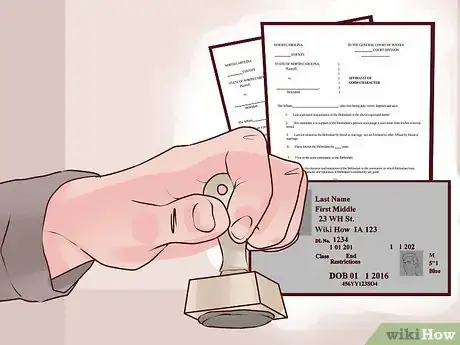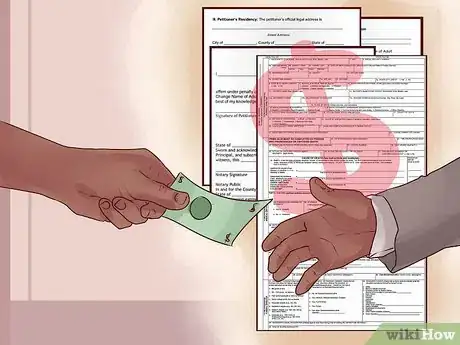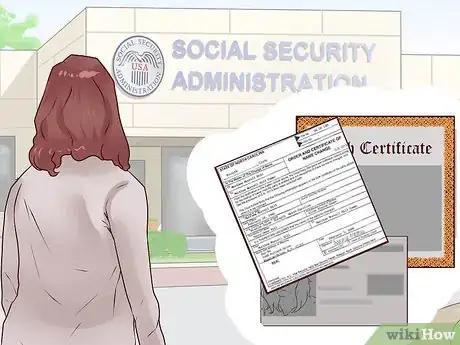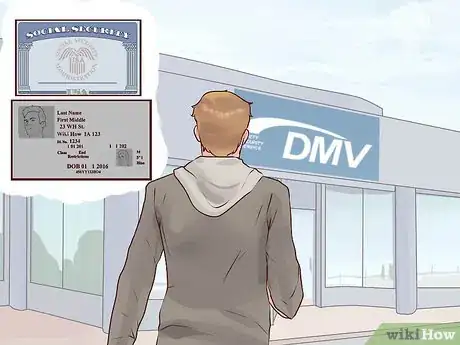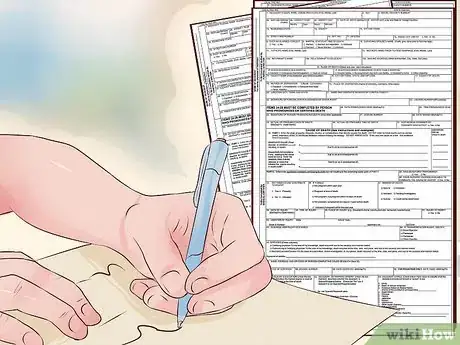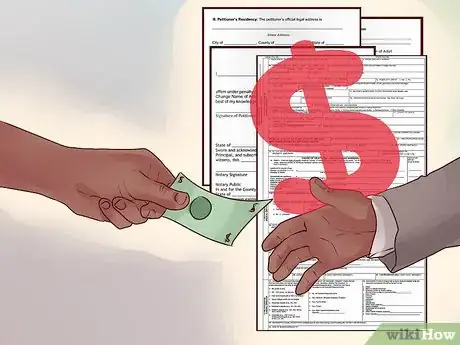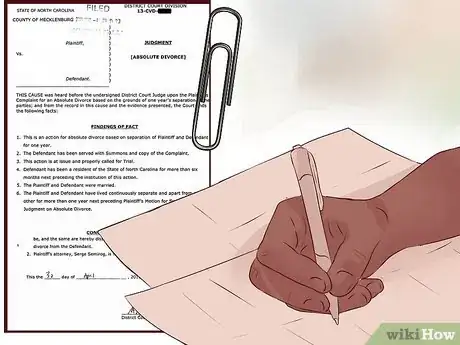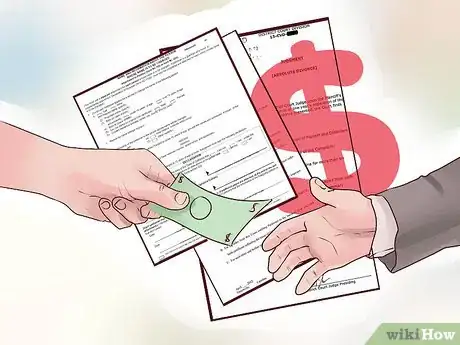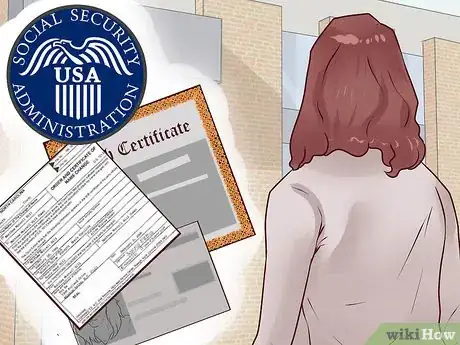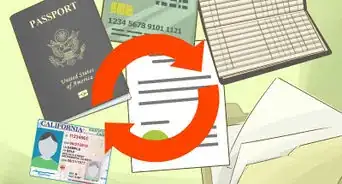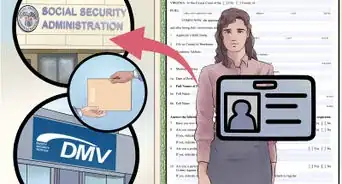This article was co-authored by Clinton M. Sandvick, JD, PhD. Clinton M. Sandvick worked as a civil litigator in California for over 7 years. He received his JD from the University of Wisconsin-Madison in 1998 and his PhD in American History from the University of Oregon in 2013.
This article has been viewed 146,578 times.
There may come a time in your life when you wish to change your name. Whether you wish to change your name following divorce, marriage, or for another reason altogether, North Carolina law does outline a procedure for doing so. By following these steps carefully, you can successfully change your legal name in the state of North Carolina.
Steps
Changing Your Name as an Adult
-
1Submit to federal and state criminal background checks. Before you can legally change your name through the Civil Clerk's Office, you must submit to criminal background checks. This requirement is to ensure that you are not trying to evade creditors or your past criminal history by legally changing your name.
- Have your fingerprints taken. Before you can have your name changed in the state of North Carolina, you must submit to a federal and state criminal records check. This step is to ensure that you are not trying to defraud your creditors or others about a crime of which you have been convicted in the past. You can have your local sheriff's department take your fingerprints. You will be charged a $10 fee in order to have your fingerprints taken and receive an original fingerprint card. After taking your fingerprints, the sheriff's department will give you an original fingerprint card that you will use for your criminal records check.
- Get a federal criminal records check from the FBI. You will need to send the FBI an Applicant Information Form, your original fingerprint card, and a certified check or money order in the amount of $18.00, made payable to the Treasury of the United States. This will serve as your request for a federal criminal records check. You can fill out the Applicant Information Form on the FBI's website by clicking here and then clicking on the “Request” button. Review the FBI's Records Checklist in order to ensure that you have enclosed all of the required information. Mail the required documents and money order to: FBI CJIS Division – Summary Request, 1000 Custer Hollow Road, Clarksburg, WV 26306.
- Request a state criminal records check. You will have to send the state of North Carolina certain documents in order to get a state criminal records check. You will need to include a written request for your criminal history, a copy of your birth certificate and a copy of your North Carolina driver's license. Enclose a money order for $14, made out to the North Carolina State Bureau of Investigation, along with the required documents. Mail these documents and money order to the North Carolina State Bureau of Investigation, Criminal Information and Identification Section, Attention: Application Unit – Right to Review, 3320 Garner Road, P.O. Box 29500, Raleigh, NC 27626-0500.
-
2Prepare the required paperwork. You must prepare and complete certain documents in order to legally change your name through the Civil Clerk's Office. There are no statewide standardized forms for this process. However, you can find sample copies of these documents by clicking here.[1]
- Complete the Notice of Intent to File Name Change. To start the name change process in North Carolina, you must first complete certain documents, including a Notice of Intent to File Name Change. This document serves as your official notice to the public that you are requesting a legal name change. It contains your current name, your new name, and the name of the county in which you live, as well as a statement that you intend to change your name.
- Complete the Petition for Name Change. This document serves as a formal request to the court to change your name. The Petition requires you to list your current name, your county of residence, your place of birth, your parents' names, and the reason that you want to change your name. In your petition, you also must certify that you have not changed your name before. In the state of North Carolina, you are only allowed to change your name one time.
- Have two people complete an Affidavit of Good Character. In order to change your name, you must have two people complete an Affidavit of Good Character on your behalf. The two people who complete these affidavits must not be related to you, either by blood or by marriage, and must reside in the same county where you are filing to change your name. Each person must sign the affidavit in front of a notary public.
Advertisement -
3Get the documents notarized. After completing your documents, you will need to sign them in front of a notary public. You can usually find one at every bank in the United States. There may be a small fee for notary public services if you do not have an account at that bank. However, services are typically free for account holders.
-
4File your completed paperwork with the Civil Clerk's Office. This paperwork includes your Notice of Intent to Change Name, Petition for Name Change, and two Affidavits of Good Character. You should file the paperwork in the Civil Clerk's Office in the county in which you live. You must be a resident of that county and show a utility bill with your address on it or driver's license to prove your residency to the county clerk's office.
- A copy of your Notice will be posted on the courthouse bulletin board for 10 consecutive business days. If the 10th business day falls on a holiday or weekend, the Notice must remain posted until 5:00 p.m. on the next business day.
- If you have concerns about your safety as a result of posting your Notice on the courthouse bulletin board or are changing your name due to a domestic violence situation, you should discuss the issue with the court clerk. You may not be required to post the Notice on the courthouse bulletin board.
-
5Pay any required filing fees. The Civil Clerk's Office will charge you a filing fee for filing your paperwork to get a name change. The amount of this fee will vary from county to county, but typically will range from $88 to $120.
-
6Receive your Order and Certificate of Name Change from the Clerk. The Clerk's Office will sign this Order. You then will receive a copy of the Order in the mail. Some counties require that you provide them with a self-addressed stamped envelope in order to get a copy of your Order by mail. This Order is the official document that you will use to change your name with any government or private office.
-
7Take your order to any offices with which you need to change your name. You can take the order, along with a birth certificate and a photo ID, to your local Social Security Administration Office in order to have the name on your social security card changed. You will need a new social security card in order to change the name on your driver's license and perhaps with other agencies, as well.
- If you are changing your name due to a domestic violence situation, you can apply for a new social security number in person through your local Social Security Administration office.
- You will receive a new card in the mail 10 to 30 days after your request for a new card is processed.
-
8Take your order, driver's license, and your new Social Security Card to the local DMV. This will allow you to apply for a new driver's license. You will have to pay a $10 fee to get a new driver's license.
Returning to Your Maiden Name After a Divorce
-
1Change your name during your divorce proceedings. If you want to change your surname back to your maiden name, you can request it in your divorce proceedings. Your divorce decree will order that your surname be changed as requested. A certified copy of your divorce decree should be all that you need in order to change the name on your social security card and with other offices.
-
2Return to your maiden name after a divorce. Most people change their surnames during their divorce proceedings. However, if you did not change your name during your divorce proceedings, and your divorce decree did not order your name to be changed, you can still resume using your maiden name after your divorce is over. A form is located in most Clerk's Offices that you can fill out and file in order to start using your maiden name again. You will be charged a fee for this service, which varies by county.[2]
- You will need to attach a copy of your divorce judgment to the form that you have filled out in order to change your surname using this method.
Returning to the Name of Your Deceased Husband
-
1Get a copy of your husband's death certificate. You will need a certified copy of the death certificate in order to change your surname in this manner. You typically can obtain a death certificate from the local or state office of vital records.
-
2Fill out a form in the Clerk's Office of the county in which you live in order to resume using the name of your prior deceased husband. You may wish to resume this name if you are a widow. This is an automatic process that does not require any notice to the public before resuming the use of your deceased husband's name.[3]
-
3Pay any filing fee that is needed to file these documents. The amount of this fee varies widely from county to county. You typically must pay court fees using cash or a money order.
Returning to the Name of Your Former Husband
-
1Change your name during your divorce proceedings. If you want to change your surname back to a previous married name, you can request it in your divorce proceedings. Your divorce decree will order that your surname be changed as requested. A certified copy of your divorce decree should be all that you need in order to change the name on your social security card and with other offices.
-
2Resume using the name of your previously divorced husband if you have children together. If you are divorced, you can still use your ex-husband's surname again, as long as you share children with him. If you do not share children with your ex-husband, you cannot automatically resume using his name. You would have to go through the Civil Clerk's Office process of giving notice and filing a petition for change of name in order to legally change your name.
-
3Fill out a form in the Clerk's Office of the county in which you live in order to resume using the name of your ex-husband with whom you share children. Most Clerk's Offices have copies of these forms for you to complete. They usually are relatively simple to complete.
-
4Attach a copy of your divorce judgment to the form in order to change your surname in this manner. You often will need to obtain a certified copy of the divorce judgment for this purpose. Attaching the judgment proves to the court that you are divorced and that you share children with your ex-husband. [4]
-
5Pay any filing fee that is needed to file these documents. The amount of this fee varies widely from county to county. You typically must pay court fees using cash or a money order.
Changing Your Minor Child's Name
-
1Get the consent of your child's other parent in order to change your child's name. North Carolina law does not permit one parent to change a minor child's name without the consent of the other parent, if both parents are living. Any parent who is on the child's birth certificate, has had paternity established by court order, or who is ordered to pay child support for a child must consent to a name change for the child.[5]
- A minor child who is over the age of 16 can change his or her name with the consent of his or her custodial parent if he or she can show that the noncustodial parent has abandoned the child, or if he or she has committed certain crimes against the child or a sibling of the child.
- The Clerk may attempt to reach the noncustodial parent if there is a claim of abandonment. The Clerk can mail a notice to the parent's last known address that it will declare the child to be abandoned by the noncustodial parent by registered or certified mail. If the parent does not respond in ten days, the child will be declared to be abandoned by that parent.
- Eligible crimes that eliminate the need for a noncustodial parent's consent for a name change include felonious or misdemeanor child abuse, taking indecent liberties with a minor in violation of G.S. 14-202.1, rape or any sex offense, incest in violation of G.S. 14-178, and assault, communicating a threat, or any other crime of violence. The parent seeking the name change must provide proof of the conviction of the other parent of the crime.
-
2Complete the required paperwork. This paperwork is similar to that required to change an adult's name. There are no statewide standardized forms that are available for use. However, sample forms are located here. The required paperwork includes the following:[6]
- The Notice of Name Change of Minor Child must be fully completed. This document gives notice that you are asking for your child's name to be changed.
- The Petition for Legal Name Change of Minor Child must be fully completed. This document asks the Clerk to change your child's name.
- You must file a Petitioning Mother Name Change Verification, if mother is the parent seeking the name change for the child. If the father is the parent seeking the name child for the child, you must file a Petitioning Father Name Change Verification.
- If the noncustodial parent is consenting to the child's name change, then you must complete a Consent to Name Change and have the noncustodial parent sign it. If the child is over the age of 16, you also will need to have two Affidavits of Good Character completed by two non-relatives living in your county. Depending on the county, you also may need to complete an Order for Minor Name Change, as well.
- If your child was born in North Carolina, you also need to complete an Application for a copy of a North Carolina Birth Certificate, which is located here. There is a $15 fee for processing the name change, $24 for the first copy of the amended birth certificate, and $15 for each additional copy of the birth certificate.
-
3File the required paperwork with the Civil Clerk's Office. All of the required paperwork must be submitted to the Civil Clerk's Office for filing. This step initiates the process to change your child's name.
- A child's name may not be changed more than two times, for good cause shown.
- The Notice of Name Change of Minor Child must be posted on the courthouse bulletin board for 10 business days. If the 10th day falls on a holiday or weekend, the Notice must remain posted until 5:00 p.m. the following business day.
-
4Attend a court hearing, if necessary. If your child's other parent does not consent to the child's name being changed, the court is likely to set a court hearing. At that hearing, the court will determine whether changing the child's name as requested is in the best interest of the child.
-
5Receive the Order for Minor Name Change from the Clerk. The Clerk's Office will sign this Order. You then will receive a copy of the Order in the mail. Some counties require that you provide them with a self-addressed stamped envelope in order to get a copy of your Order by mail. This Order is the official document that you will use to change your child's name with any government or private office.
-
6Take your order to any offices with which you need to change your child's name. You can take the order, along with a birth certificate and a photo ID, to your local Social Security Administration Office in order to have the name on your child's social security card changed.
References
- ↑ http://www.ncga.state.nc.us/EnactedLegislation/Statutes/HTML/BySection/Chapter_101/GS_101-2.html
- ↑ http://www.harnett.org/clerk/name-change-.asp
- ↑ http://web.co.wake.nc.us/courts/namechanges.html
- ↑ http://web.co.wake.nc.us/courts/namechanges.html
- ↑ http://www.ncga.state.nc.us/EnactedLegislation/Statutes/HTML/BySection/Chapter_101/GS_101-2.html
- ↑ http://ncfcc.us/minor-child-name-change
About This Article
If you live in North Carolina and want to change your name, you'll first need to submit federal and state criminal records checks to confirm that you're not changing your name to evade a conviction. Next, complete the documents to get your name changed, including a notice of intent to file name change, and get them notarized. When your paperwork is complete, file it at the civil clerk's office and pay the filing fee. Finally, wait to receive the name change order from the civil clerk, which you can use to change your name at other offices. For tips on how to change your name after a divorce, read on!



